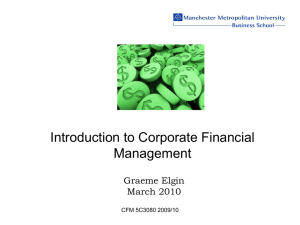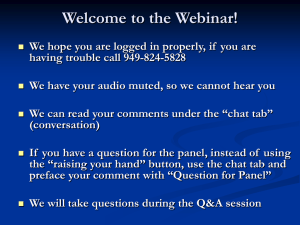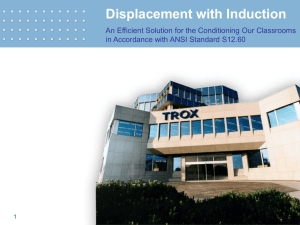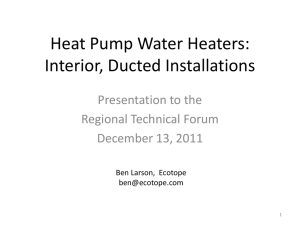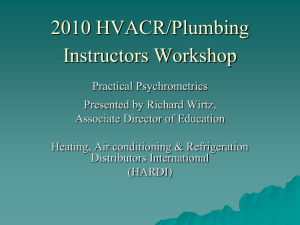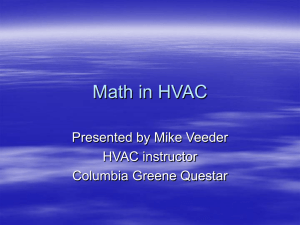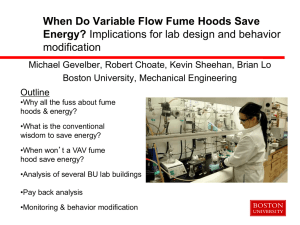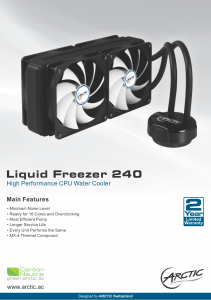Strategies For Reducing Energy Usage in Your Labs By Up To 50%
advertisement
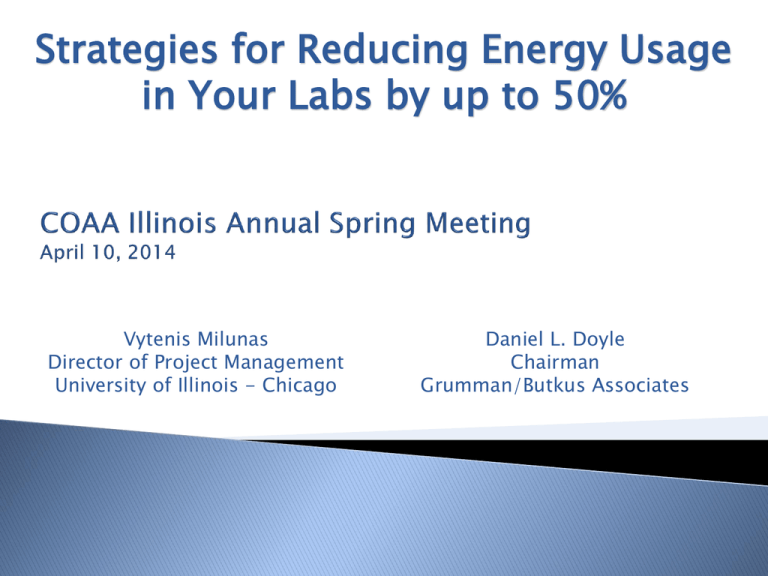
Strategies for Reducing Energy Usage in Your Labs by up to 50% Vytenis Milunas Director of Project Management University of Illinois - Chicago Daniel L. Doyle Chairman Grumman/Butkus Associates Course Description This presentation will discuss some general strategies for designing and operating high performance, energy-efficient laboratories. The air handling systems usually account for the largest amount of energy usage in a lab and are therefore the most important component of an energyefficient system. First, airflow should be reduced as much as possible. Strategies such as reducing cooling loads in the space, reducing the air exhausted by fume hoods and other exhaust sources, and reducing the required air change rate of the space will be discussed. Strategies that can further reduce energy use, including demand-controlled ventilation and energy recovery systems, will all be discussed. Learning Objectives At the end of the this course, participants will be able to: 1. Identify energy efficiency considerations for laboratory planning 2. Identify ways to reduce cooling loads with efficient equipment and lighting 3. Describe the process for determining the required airflow to a space and strategies to reduce this airflow 4. Summarize options for reducing the energy required for cooling and reheat 5. Understand additional elements of high performance laboratory design 6. Summarize best practices strategies to achieve energy usage reduction of up to 50% Laboratories are energy intensive. ◦ Labs21 data indicates that labs consume about 3-8 times as much energy as a typical office building. ◦ On some campuses, labs consume twothirds of total campus energy usage. Most existing labs can reduce energy use by 30% to 50% with existing technology. Reducing laboratory energy use will significantly reduce carbon dioxide emissions. 4 Reduced operating costs. Improved environmental quality. Expanded capacity. Increased health, safety, and worker productivity. Improved maintenance and reliability. Enhanced community relations. Superior recruitment and retention of scientists. 5 This presentation provides specific strategies that can result in energy efficient and eco-friendly laboratory designs; reducing energy use by as much as 50% as compared to a laboratory designed to comply with ASHRAE Standard 90.1 Energy Use (Percentage of Standard Design) 100% Strategy Standard Building Design Energy Star and High Efficiency Equipment High Efficiency Lighting Occupancy Sensors for Lighting and Equipment Daylighting Controls Variable Air Volume Air Distribution 50% Demand Control Optimization Ventilation Exhaust System Demand-Controlled Ventilation Enthalpy Recovery Wheel Low Pressure Drop Wheel Designwith Passive Desiccant Enthalpy Recovery Dehumidification Air-To-Air Energy Recovery Strategies 6 7 Incorporate lowest cost/highest energy savings features first. 8 High efficiency fluorescents (T5’s, T8’s) and LEDs Occupancy sensors Dimming/bi-level switching to take advantage of daylighting Use Energy Star equipment ◦ Use only EnergyStar rated equipment for things such as small refrigerators and desktop electronics. ◦ All new PC’s, printers at UIC are Energy Star rated 10 Much more efficient freezers are now available ◦ Ultra-low temperature freezers with Stirling Engines; 30% to 50% savings – I2SL Webinar available on website ◦ Minimize the number of freezers and other large energy consuming equipment ◦ Centralize to allow to be shared by the maximum number of labs. 11 Lab Planning Strategies ◦ Minimize number of hoods ◦ Minimize size of hoods Can a 4’ suffice in lieu of a 6’ ◦ Use low flow/high performance hoods Determine driver of lab airflow rate Largest of 1. Make-up air required to offset the total exhaust (fume hoods, snorkel exhausts, some type of bio-safety cabinets). 2. The airflow required to adequately cool the space. 3. The required lab air change rate UIC: 8 ach 13 Make-up air driven: ◦ Total exhaust = sum of exhaust from all devices Fume hoods: Use maximum fume hood airflow - the airflow required when the face velocity is at its maximum and the sash is fully open. ◦ Reducing number: Install the minimum number of exhaust devices possible. Using low flow fume hoods 14 Lab Air Change Rates: ◦ The Labs21 Design Guide section on room air change rates states that: “The conventional, "national consensus standard" has been 4 to 6 outside air changes per hour recommended for a "safe" B-occupancy laboratory ◦ Suggest using 4 ach maximum in standard laboratories. ◦ Consider increasing only when absolutely necessary; such as for carcinogenic materials. 15 Agency Ventilation Rate ASHRAE Lab Guides 4-12 ACH UBC – 1997 1 cfm/ft2 IBC – 2003 1 cfm/ft2 IMC – 2003 1 cfm/ft2 U.S. EPA 4 ACH Unoccupied Lab – 8 ACH Occupied Lab AIA 4-12 ACH NFPA-45-2004 4 ACH Unoccupied Lab – 8 ACH Occupied Lab NRC Prudent Practices 4-12 ACH OSHA 29 CFR Part 1910.1450 Recommends 4-12 ACH ACGIH 24th Edition, 2001 Ventilation depends on the generation rate and toxicity of the contaminant and not the size of the room. ANSI/AIHA Z9.5 Prescriptive ACH is not appropriate. Rate shall be established by the owner! Next we need to determine Airflow Required to Cool the Lab ◦ Thermal load calculations shall be performed in accordance with ASHRAE procedures 17 Minimize supply air required for cooling by: ◦ Using energy efficient lighting ◦ Using Energy Star equipment such as PCs, printers, copiers or refrigerators and freezers ◦ Using the most energy efficient lab equipment available ◦ Use equipment with remote (outside) heat rejection ◦ Do not overestimate the equipment load in the labs from which the thermal loads are calculated. ◦ Consider de-coupling cooling load: fan coils/chilled beams 18 Determine the Controlling Airflow ◦ Compare all three airflow requirements ◦ The largest airflow will determine the lab airflow requirements Fume Hoods # of Hoods Fume Hood Dominated Air Change Dominated Thermal Load Dominated Exhaust Airflow per Hood Lab Air Changes Min Hood Make-Up Airflow Room Dimensions (WxLxH) Min ACH Min Lab Airflow Thermal Load Min Cooling Load Airflow Final Requirements Min Lab Airflow Max Airflow driven by 4 600 cfm 2,400 cfm 40’x20’x10’ 6 800 cfm 400 cfm hoods 2,400 cfm 1 600 cfm 600 cfm 40’x20’x10’ 6 800 cfm 400 cfm min air change 800 cfm 1 600 cfm 600 cfm 40’x20’x10’ 6 800 cfm 1,200 cfm thermal load 1,200 cfm If the controlling airflow is significantly higher than the others, consider ways to further reduce the controlling airflow. 19 Low flow hoods save significant energy, particularly in constant volume systems Good sash management (with VAV) is the most effective method of reducing flow, regardless of hood type Low flow hoods may be a good solution in buildings with limited HVAC capacity 20 Strategy to reduce cooling airflow: ◦ If thermal loads are high and driving the airflow, consider decoupling the thermal load from the room airflow by using water-based cooling: Chilled beams Fan coil units Be careful of condensation on chilled beams if humid air can enter the space. 21 Incorporate next highest level on the pyramid – still relatively low cost with high energy savings. 22 Airflow is actively modulated below the design maximum during part load or unoccupied conditions. Reduction is in response to certain criteria in the lab: ◦ Temp, sash position, air quality This reduces fan, heating, cooling and dehumidification energy consumption at the AHU. 23 Fume Hoods • Use variable air volume (VAV) exhaust devices: Allows for reduction of flow when sash is not fully open or when hood is not in use. Consider occupancy sensors, auto sash closers • Use VAV in combination with high performance (low flow) fume hood. 24 Specify ventilated cage racks in animal labs • Lower room air change rates (from 10-15 to 8 to 10) • Provide better conditions for the animals • Reduce frequency of cage changes 25 VAV terminal units (such as Venturi Valves) will be required on: ◦ ◦ ◦ ◦ General Exhaust Valve Each fume hood Groups of snorkels Some bio-safety cabinets Supply air from AHU VAV Supply Air Valve Fume Hood Exhaust Valve 26 Demand-Based Ventilation Controls: ◦ Actively senses quality of air in labs by sensing for certain chemicals. ◦ Lab air change rates are reduced when not necessary to control air quality in lab. 27 Reduce air changes per hour (ACH) if no contaminants detected Increase air changes per hour (ACH) when contaminants detected 28 Incorporate third highest level on the pyramid – mid range cost with good energy savings. 29 95% MERV 14 Filter Typical Pressure Drops Filter Type Pressure Drop (inches WG)* Std 12 inch deep box style rigid media filters 0.61 12 inch deep low pressure drop V-bank type mini-pleat filters 0.37 Electronic filters 0.20 *Initial clean filter pressure drops @ 500fpm Up-size cross section of AHU to reduce face velocity and pressure drop across filters, cooling coils, etc. ◦ Traditional design: 500 fpm ◦ Low pressure drop design 300 fpm (or as low as space allows) For a 10,000 cfm AHU, cross-sectional dimensions will increase from: 5 ft wide by 4 ft tall to 6 ft wide by 5.5 ft tall The net incremental cost is small ◦ Bigger sheet metal box ◦ Coils, filters are larger ◦ Motors, VFD’s are smaller ◦ Can often eliminate sound attenuators, mist eliminators Simple reliable energy savings over the life of the AHU! ◦ Can never be “overridden” Reducing pressure drop in AHU reduces the power required to drive the fan: ◦ Fan at 10,000 cfm and 7” w.g. static pressure 13.5 kW/18.0 bhp ◦ Fan at 10,000 cfm and 4” w.g. static pressure 5.8 kW/7.8 bhp Options Analysis for 30,000 cfm AHU: Base Case (500 fpm): Pre and secondary filters, preheat coil, cooling coil, single centrifugal fan, conventional final filters, 5’ sound attenuator Option 1 (400 fpm): Pre and secondary filters, preheat coil, cooling coil, fan array, low pressure drop final filters, 3” sound attenuators Option 2 (300 fpm): Pre filters, preheat coil, cooling coil, fan array, low pressure drop final filters, no sound attenuators Design Static Pressure AHU First Cost Annual Energy Reduction as compared to Base Case Simple Payback ComEd Utility DSM Incentive Base Case (500 fpm) 8.5” $150,000 - - - Option 1 (400 fpm) 6.0” $145,000 $4,400 Immediate $3,655 Option 2 (300 fpm) 4.5” $160,000 $10,200 Two months $8,384 400 fpm design in usually a “no brainer”! Between 300 fpm and 400 fpm will have a good payback 36 Air quality sensor Slightly higher stacks, 4-5 feet controls 37 Incorporate energy recovery: higher energy savings for higher cost. 38 Now required by IECC Energy Code Energy Recovery Requirements • Chicago (Zone 5A) HR required if AHU>5,500 cfm and 30%<OA≤40% HR required if AHU>4,500 cfm and 40%<OA≤50% HR required if AHU>3,500 cfm and 50%<OA≤60% HR required if AHU>2,000 cfm and 60%<OA≤70% HR required if AHU>1,000 cfm and 70%<OA≤80% HR always required when OA >80% Wheels ◦ Enthalpy and desiccant ◦ Highest effective recovery ◦ Restrictions: not for hazardous exhaust ◦ Need adjacent airstreams Heat Pipe ◦ Effective recovery ◦ Little maintenance ◦ No moving parts ◦ Requires less space than wheel Plate Heat Exchanger ◦ Effective heat recovery ◦ Little maintenance ◦ Large ◦ Need adjacent airflows ◦ More commonly used for residential Pumped Run-Around ◦ Glycol or Refrigerant ◦ Less effective recovery ◦ Maintenance required ◦ Airstreams can be far apart ◦ Most common option for retrofits Real world example: ◦ Two 18,000 cfm 100% OA AHUs ◦ Heat pipe heat recovery ◦ Heat recovered from toilet exhaust ◦ Economics: Increased first costs: $40,000 Energy savings after 3 years: $50,670 Payback less than 3 years! What are other high performing lab facilities doing? 45 University of California, Irvine: Smart Labs Initiative http://www.ehs.uci.edu/programs/energy/index.html ◦ Goal: Outperform ASHRAE Standard 90.1/CA Title 24 by 50% On track to reduce electric usage by 20% from 2010 to 2012 Expect to reach 40% reduction by 2014 ◦ Combine initiatives such as: Demand controlled ventilation (DCV) Low flow/high performance fume hoods Reduced building exhaust stack airspeeds Energy efficient lighting 46 Current Best Practice Smart Lab Parameters UIC Current 400 ft/min. max 350 ft/min. max 400-500 FPM 6 in. w.g. <5 in. w.g. (incl. dirty filter allow.) 6” w.g. in purge 4” to 5” normal operation Few None Project specific 6 ACH 4 ACH w/ contaminant sensing 6 ACH (NIH min) 12 ACH (purge) No setback 2 ACH w/ occupancy + contaminant sensing + no thermal inputs during setbacks No setback No Yes, where hood density warrants Project specific Fume hood face velocities 100 FPM 70 FPM (low-flow hoods) 80 FPM Fume hood face-velocities (unoccupied) 100 FPM 40 FPM (low-flow hoods) No unoccupied mode None Where hood density high Project specific Exhaust stack discharge velocity ~3,500 FPM Reduce or eliminate bypass air, wind responsive controls ~3000 FPM Lab illumination power-density 0.9 watt/SF 0.6 watt/SF w/ LED task lighting 1.0 watt/SF retrofit buildings Fixtures near windows on daylight sensors No Yes No Energy Star freezers & refrigerators No Yes Yes 20-25% 50% NA, use IECC Air-handler/filtration airspeeds Total system (supply + exhaust) pressuredrop Duct noise attenuators Occupied lab air-changes/hr. (ACH) Night air-change setback (unoccupied) Low-flow/high performance fume hoods Fume hood auto-closers Out-perform CA Title 24 47 Vytenis Milunas Director of Project Management University of Illinois - Chicago vmilunas@uic.edu (312) 413-1361 Dan Doyle, P.E., LEED AP Chairman Grumman/Butkus Associates ddoyle@grummanbutkus.com (847) 316-9219 48
